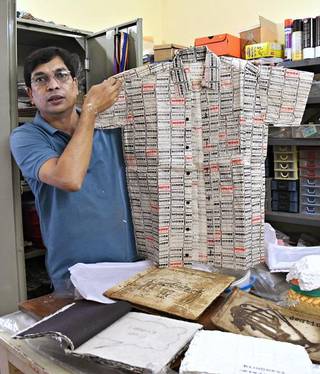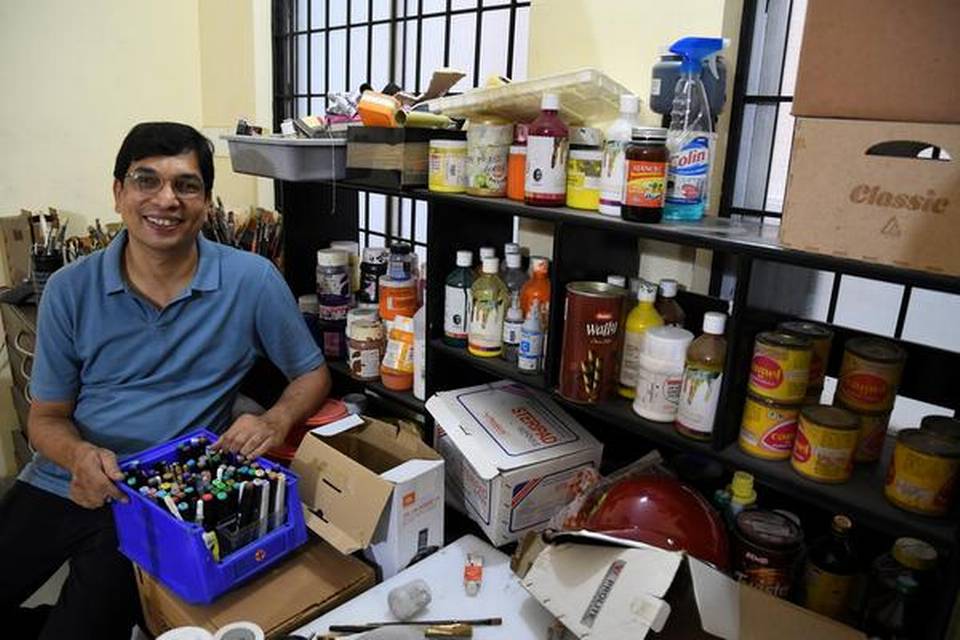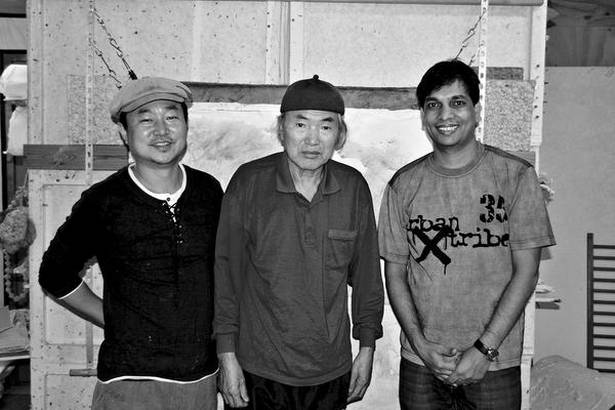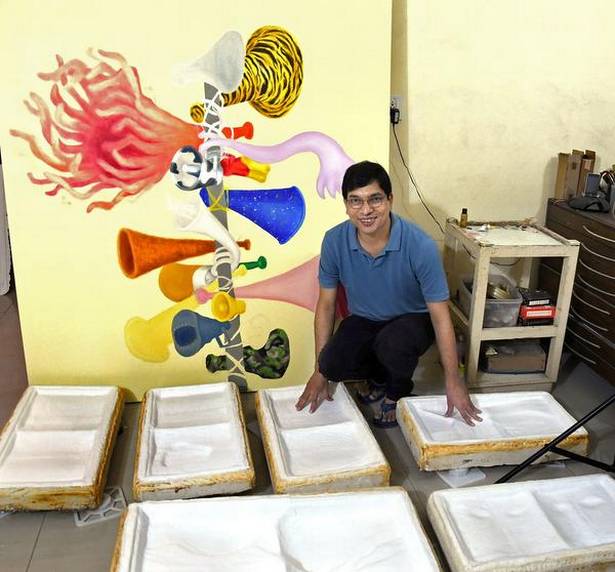Acclaimed artiste Ravi Kashi says he responds to his times with imagery that is poetic and suggestive, he does not believe in being direct
Order and chaos meet here. Pragmatism and innovation walk parallel to each other. Ideas are researched, moulded, shaped, changed and rethought. At times, concepts work and at others, they remain unresolved. It is for a good reason that Ravi Kashi calls his studio a working lab. It is a space where he invites students and young artists generously for sharing of knowledge and to even try their hand at paper-making. A rented three room house in Nagarbhavi that functions as his studio, has a mini pulp-beater, ready paper pulp in several containers, a variety of handcrafted papers, his books, book objects, catalogues, colours, brushes, and all other paraphernalia needed by an artist. And of course, paintings, what he trained to be in the 90s, after pursuing BFA and MFA from Chitrakala Parishath in Bengaluru and MS University Baroda, respectively.
We enter his studio to find a painting in progress along with a few paper sculptures that have been put to dry. It is almost after a decade that Ravi has come back to paintings. All this while, the paper kept him preoccupied. “My paintings had become predictable. Now when I have my show of paintings, most probably next year, they will be different,” says Ravi.
For someone who is acutely conscious of stagnation and repetition, Ravi has always strived to push the frontiers so much so that he chose a niche medium like paper. The lure to sell and pander to the market was way less stronger than the urge to “enjoy the process”. Even with the medium of paper, Ravi didn’t stop at any one thing. Over the years, he has experimented with art books, book objects, and photo-books. His studio is filled with papers made with an array of fibres – Abaca, Daphne, Montbretia, Arecanut, Banana, Daphne bark, Hanji paper of Korea and tea-stained paper.
The tactility of paper fills him with joy him but more than that it is the challenge of working with what seems like a flat surface. “I make sculptural forms, objects, and installations out of it. Paper seems like a flat surface, but it is not. Paper is so versatile. I keep discovering different aspects to it,” the artist expresses.

Invitation to an artist’s studio is exclusive and even more special is the opportunity to try your hand at an artistic process. Ravi encourages me to make sheets and discover the joys of paper-making for myself.
In large rectangular containers floats the paper-pulp. A window-screen attached to a wooden frame is dunked into the container and lifted out. This frame is usually referred to as mould and deckle. On a table is spread a fine white cloth. After detaching the wooden frame, the window screen is pressed against the cloth. The sheet transfers on to it. Another white cloth is kept over it and water is drained out with the help of sponge wipes. The paper is most malleable at this stage so you can create impressions and textures with the help of different objects. Ravi hands me colourful tassels and threads which I cut and sprinkle over the wet sheet. A roller is moved embedding them all.
Learning the ropes
Ravi first came across paper-making at Visvesvaraya Industrial and Technological Museum in Bengaluru as a 12-year-old, and found himself drawn to it. Later, at Kanoria Centre for Arts in Baroda, he saw a paper-making workshop in progress. Back home in Bengaluru, Ravi discovered ‘Vishwaneedam’, a Khadi handmade paper making unit near his house. He would buy ready pulp from there and use it in his work. “Around 1997-98 I started using this recycled pulp for casting various objects/forms. One such work called ‘Encounter’ got me the National Academy award.”
Ravi considers his visit to Glasgow School of Art on a Charles Wallace Grant, a turning point in his career. “My teacher Jacki Parry, a printmaker, and fibre artist was a faculty member in Printmaking Department and the paper-making unit was attached to the sculpture department, which was far away. So, every week we would fix a time when she could come and teach me the intricacies of the medium. At the end of the term, I had a show in the faculty. After returning, I continued using the medium and had several shows of paper-based works.”
That wasn’t enough. After discovering the Hanji Paper during the Korean International Art Fair, Ravi decided to learn the technique. After much research, he zeroed in on a practitioner, Seang Woo residing in a small remote village Jang Ji Bang, located on the border of North Korea. Ravi lived there for a month learning not just to make Hanji but also Washi, the Japanese paper. “Hanji is a special paper out of Mulberry bark and it’s made organically. The sheet making is very different. Like here, I took out the sheet in one go but in Korean technique, you make six different and very thin layers. That becomes one part of the sheet. There are 12 layers in one Hanji sheet. It was quite strange for people there that someone from that far has come to learn papermaking. TV channels came to interview me,” recalls the artist.
Booked for life
Ravi wasn’t aware of the format of artist’s books until he saw it abroad. Today, he participates in artists’ book fairs and triennials across the world and a few of his works have been acquired by important collectors, foundations and museums. He makes his books using his own handmade paper. The books are either sheets bound together or cast in the shape of a book. “In my books, images and text are sometimes drawn; many times a relief image is created in clay and later converted into pulp, casting from a prepared mould and occasionally transferred from a photocopy. In some of my books like ‘Banana and the sword’, I have tried to reinterpret the palm leaf manuscripts format from ancient India. In other works like ‘This is the way the world ends’ I have adopted the accordion format along with a few unconventional approaches to bookmaking, but most of my artists’ books retain the form of a book.”
In a book done in the watermark technique, he shows two people arguing. Sometimes, they become a victim and at other times, aggressor as they play the game of blaming and defending. His minimalistic artistic books often draw from more intimate aspects of life like human relations. Even Ravi’s book objects, photo-books, relief work arouse philosophical concerns that borrow from punch cards used in the earliest computers; grids, unfocused photos in terms of imagery.
Reclaiming to find newer meanings
There is also a penchant for words. They first appeared diligently in his paintings and remain an integral part of his paper works too. The reason for this is rooted in Ravi’s fondness for literature. The artist makes use of words, phrases, sentences and alters them to find new meanings just like the images he would reclaim from popular culture, particularly in his earlier paintings.
Small glass cabinet, boat, and several other found objects go through the same ritual. The references are made cleverly with metaphors and personal and universal are ensconced in layers. A take on power and aggression is portrayed by painting an array of loudspeakers, big and small, suspended from a ceiling.
“Even if there is political content, it is suggestive. I am not an activist artist in that sense. I respond to my times but the imagery is poetic and suggestive and it is not so direct that the minute the event is over, my work will be irrelevant. Any artwork has to first succeed as an artwork because they have to survive longer cycles.”
Teaching and writing
After art making comes the other two loves of his life teaching and writing. According to the versatile artist, the strands connect to complete the narrative.
After completing his MFA from Baroda, Ravi pursued Masters in English from Mysore University. He is probably the only visual artist to have got a Sahitya Kala Akademi award for his writing. His two books written in Kannada, Anuktaand Kannele were seminal writings on Indian art that won him acclaim. Kannele got fetched him the Karnataka Sahitya Kala Akademi Award in 2015.
His third book “Flexing Muscles”, published by Reliable Copy, is an observation of the culture of flex banners in the city through an essay in Kannada/English and images. It will be released in September.
He has been a visiting faculty at RV College of Architecture where he teaches visual design, and visual creativity. In 2015, he also taught one semester open course in Art Appreciation at Azim Premji university.
Teaching helps him in several ways – firstly, keeping in touch with the younger generation keeps him updated and also supplements his income. “The kind of work I do doesn’t sell much, but I need resources in order to practise. Teaching also helps because when you have to tell someone else you need to be doubly sure. It enriches my art too. Something, I am trying in my studio will go to the classroom and vice-versa.”
source: http://www.thehindu.com / The Hindu / Home> Entertainment> Art / by Shailaja Tripathi / August 29th, 2019


